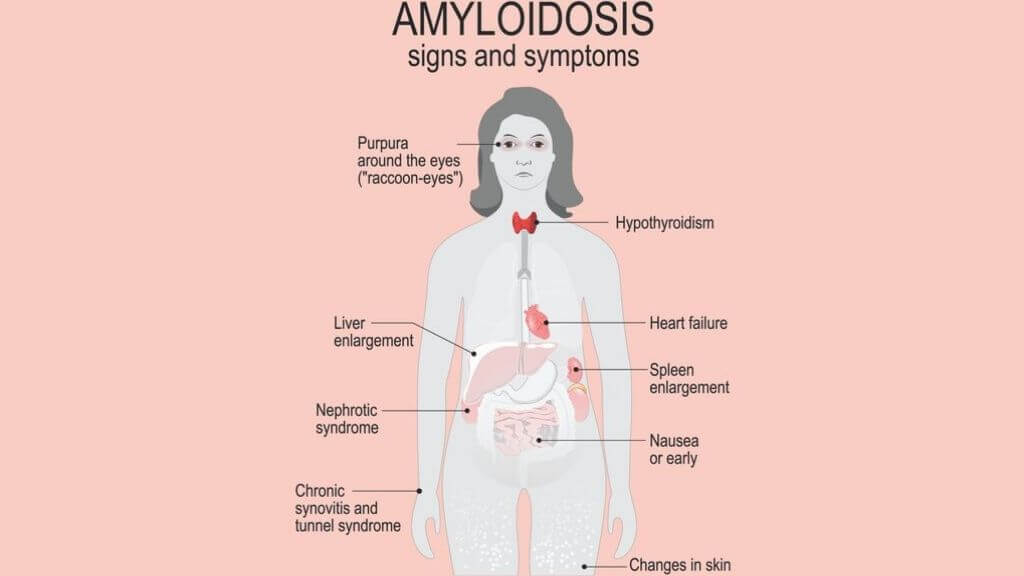Amyloid is a protein that is deposited in the liver, kidney, and spleen as a result of certain diseases. Amyloidosis is the condition that causes this abnormal protein to build up in the body.
Amyloid deposits form during amyloidosis, which damages organs and causes organ failure. The condition is rare, but it can be very serious, as it can affect many organs, including your heart, liver, kidneys, intestines, joints, and skin.
What Causes Amyloidosis?
The causes of the amyloid accumulation depend on which type of amyloidosis you have. The common causes include:
♦ Inherited mutated genes
♦ Dialysis for an extended period of time
♦ Inflammatory diseases such as rheumatoid arthritis
♦ Bacterial or viral infections
♦ Abnormal antibodies produced in the bone marrow
What Are the Variations of Amyloidosis?
Amyloidosis is the accumulation of amyloid proteins in your organs, and how the amyloid gets there depends on which version of the condition you have.
♦ AL amyloidosis: Light chain or AL amyloidosis, is the most common type. Also known as primary amyloidosis, the abnormal proteins accumulate in your liver, heart, kidneys, and skin.
♦ AA amyloidosis: Autoimmune amyloidosis occurs after infections like tuberculosis or an inflammatory disease. This version only affects your kidneys, but can sometimes damage your intestines and liver too.
♦ Cardiac amyloidosis: When the amyloid deposits accumulate in your heart tissues, they make it difficult for your heart to function properly.
♦ Dialysis-related amyloidosis: This affects people who have been on dialysis for a while as a result of kidney issues. The deposits build up in the joints causing pain and stiffness.
♦ Hereditary amyloidosis: This is the rarest version and is caused by a mutation in a gene that runs in families. It affects the nerves, heart, kidneys, and liver.

Amyloidosis Symptoms
Although there may not be any symptoms with many cases of amyloidosis, general symptoms will include:
♦ Fatigue
♦ Weakness
♦ Bruising around the eyes
♦ Swollen tongue
♦ Joint pain
♦ Carpal tunnel syndrome
When the condition becomes severe the symptoms will start to show, and symptoms will vary depending on the organ that is affected.
♦ Heart: Symptoms include shortness of breath, chest pain, irregular heartbeat, and lower blood pressure
♦ Kidneys: Symptoms include swelling in your legs from fluid buildup and foamy urine
♦ Liver: Symptoms include pain and swelling in the upper abdomen
♦ Intestines: Symptoms include nausea, diarrhea, constipation, and feeling of fullness after eating
Amyloidosis Diagnosis
Your doctor needs to know your medical history and your symptoms to accurately diagnose amyloidosis. The symptoms can appear similar to those of other disorders, so you need to be very accurate in your descriptions to your doctor. Several tests can also be done to diagnose the condition more accurately.
♦ Blood tests can assess the levels of amyloid protein in the blood.
♦ A biopsy will examine tissue from an organ to figure out which type of amyloid deposit you have.
♦ A bone marrow aspiration involves using a needle to remove fluid from the bone marrow to test for amyloidosis. Some white blood cells are responsible for creating this abnormal protein and can be identified with this procedure.

Amyloidosis Treatment
There is no cure for amyloidosis, but treatment can slow the amyloid protein production, which will reduce your symptoms. Medications such as pain relievers, drugs to manage gastrointestinal disruption, diuretics, and blood thinners are all used to reduce and control symptoms.
Additional treatments will be prescribed based on which type of amyloidosis you have.
♦ AL amyloidosis: This is typically treated with chemotherapy, which will destroy the abnormal cells producing the protein. You may require one marrow stem cell transplant to replace the cells that are destroyed.
♦ AA amyloidosis: This is treated depending on the cause. Bacterial infections will require antibiotics, and inflammatory conditions will be treated with medications to reduce inflammation.
♦ Dialysis-related amyloidosis: This can be treated by changing the type of dialysis you are getting, or you can have a kidney transplant.
♦ Hereditary amyloidosis: The abnormal protein, in this case, is made in the liver, so the only option is a liver transplant.
Amyloidosis Diet
There is no cure, so the goal of any treatment plan is to avoid amyloid buildup in the first place. You can achieve this through a balanced and healthy diet.
The Mediterranean diet and those rich in antioxidant-rich fruits and vegetables are the best. You can also eat to support healthy organs, which will make them stronger in the presence of amyloid plaques.

Natural Treatments for Amyloidosis
These treatments can help ease symptoms, and they work best when used in conjunction with prescribed medications and dietary changes.
♦ Keep moving: Amyloidosis can cause weakness and fatigue, but regular exercise can combat this and keep you happy and healthy. Moderately-intense activities are the best such as Tai Chi, yoga, walking, swimming, and light weight-training.
♦ Sleep therapy: When you are fatigued all day, it can be challenging to sleep at night. Napping during the day makes this worse. Insomnia at night will only increase your fatigue the next day, so you need to promote regular and restful sleep patterns. Meditation and deep breathing, as well as a regular bedtime routine, will help achieve this.
♦ Massage: Pain and swelling as a result of amyloidosis can cause severe foot pain. A regular foot massage can help increase circulation to the area, soothe aching muscles, and relieve pain and discomfort.
Amyloidosis Surgery
Surgery for amyloidosis is only ever required if the affected organ has been severely impacted. In these cases, organ transplant is the only option to restore the organ to healthy function.
The problem is that transplant is not appropriate for everyone, especially those who have had a large amount of amyloid accumulation in the organs. It can also take a long time to be approved and placed on a waiting list for a donor organ.
Amyloidosis Statistics
♦ 4,000 people develop AL amyloidosis in the United States every year.
♦ The disease is typically diagnosed between the ages of 50 and 65.
♦ People as young as 20 years of age have been diagnosed, but these younger cases are rare.
♦ Two-thirds of all amyloidosis patients are male.

Amyloidosis and Children
Amyloidosis can affect children in the same way it affects adults. Children can develop the same types of amyloidosis and will present with similar symptoms.
Treatment for children will depend on the type of amyloidosis they have. Treatments will be most effective when a diagnosis can be made early. Without prompt treatment and intervention, the complications that can develop include heart damage and failure, kidney damage, and nerve damage.
What Is the Long-Term Outlook?
Amyloidosis is incurable, but with amyloid control treatment plans, you can effectively control symptoms and manage the condition. You need to discuss treatment options with your doctor once the type of amyloidosis you have is diagnosed.
If one treatment plan is not working, it is important to find another that will more effectively address the symptoms. By reducing symptoms, you will improve your quality of life.






